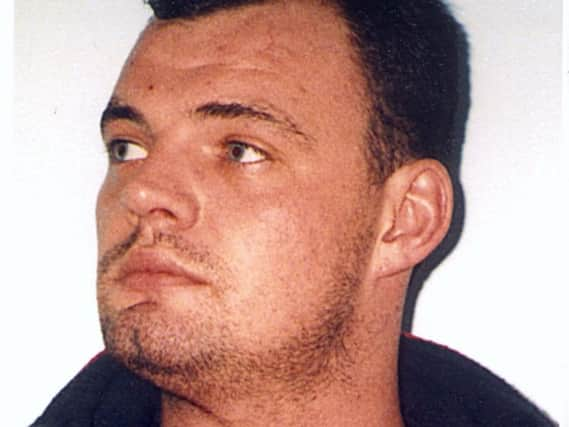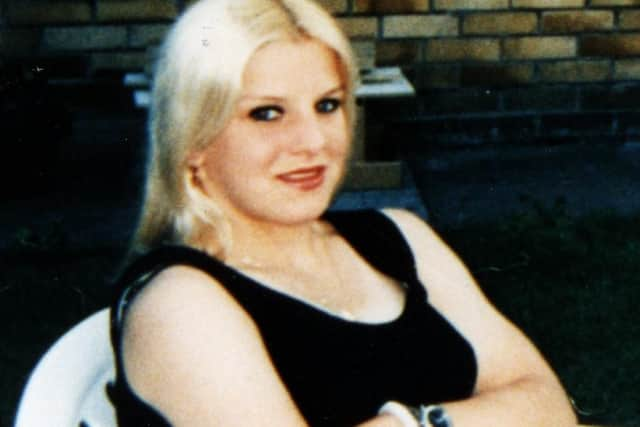Murdered Wigan teen's mum pleads: 'Do not let killer walk free'


It is 18 and a half years since Darren Ashurst was given a life sentence for beating and strangling Appley Bridge schoolgirl Louise Sellars to death in 1995.
The tragedy had a devastating effect on the 15-year-old’s family, leading first to mum Elaine and adoptive father Gary to split and, more recently, Mrs Sellars has revealed, to her ex taking his own life.
Advertisement
Hide AdAdvertisement
Hide AdThe Wigan Post reported in November 2017 that Ashurst had been moved to a lower category of prison, was being allowed an escorted town visit and had applied for parole.


And now Elaine has revealed that she attended the parole hearing for his impending release, although she and her tormentor didn’t come face to face, and there will now be an agonising two-week wait before discovering whether his bid for freedom has been successful or not.
Her victim impact statement describes how the pain is still raw, worsened by the fact that the now 45-year-old murderer has shown no sign of remorse and fearing he is not rehabilitated.
She wrote: “Not only did Darren Ashurst deem to take the life of my beautiful inside and out first-born child, he changed our family’s lives forever.
Advertisement
Hide AdAdvertisement
Hide Ad“My successful husband and partner of 20 years became a shell of his former self, taking drink and prescription drugs as his only comfort which ultimately led to our divorce and to his ultimate destruction by taking his own life.
“My two children had to deal with not only their sister who they both adored being taken from them but their father as well. My son, who was 10 at the time of Louise’s death, went from being a bubbly, fun-loving extroverted child to a child who was introvert, sullen and wanting to fight the world.
“His heart was broken. My youngest was only two years old but her early years were made up of being hounded by the press, police officers in and out of the house and not understanding why ‘Weese’ wasn’t at home and constantly asking for her.
“Myself, a piece of me died when my Louise did. There is nothing worse in this life than losing a child, but especially when your beautiful child had her whole life ahead of her, is healthy, happy and was passionate about her horses and a successful showjumper, was predicted A*s in all her exams and looking forward to becoming a PE teacher. She was loved by everyone she met.
Advertisement
Hide AdAdvertisement
Hide Ad“To see Louise leave the house that afternoon with a smile and a flick of her hair saying ‘see you later, I won’t be late’ and never to see her again because Darren Ashurst decided by his hand it would be Louise’s last day on earth is beyond comprehension.”
Elaine then goes on to ask questions about his lack of contrition and possible continued risk to society if let out:
She wrote: “We hear he has been a model prisoner. Does this guarantee that he is a model citizen if released? As he has never admitted his guilt or shown an ounce of remorse, has his homicidal instinct been faced and dealt with?
“Are we willing to gamble and let him back into the outside world and hope that our society will be safe? Has his sinister and calculated behaviour really changed?
Advertisement
Hide AdAdvertisement
Hide Ad“The most troubling thing to me is that we still have the WHY question out there. He had the choice and he chose to murder my child.”
The manhunt for the Shevington High School pupil’s killer began on August 14, 1995 when her body was found in a remote copse behind Billinge Hospital.
Detectives concluded that athletic Louise had put up a brave fight but had been ferociously beaten, stamped on and strangled in a frenzied attack.
Retired policeman Keith Wilkes discovered her in a field 500 yards from the hospital early in the morning as he walked his dogs.
Advertisement
Hide AdAdvertisement
Hide AdIt was thought she had been attacked nearby in a secluded “lovers’ lane” and her body dragged through the copse.
Louise had last been seen by friends the previous evening. She and pal Kelly Morrisey had walked down from Shevington Late Shop to Randall’s Corner and spent around two and a half hours there. Other friends had arrived but driven off, leaving Louise alone.
After a brief visit to another friend, the youngster was last spotted at 9.30pm walking down Miles Lane back towards Randall’s Corner and away from her home in Chisacre Drive.
When Louise did not return home by 11pm Gary and Elaine began to get very worried, contacted the police and began searching the area themselves. It would be the following morning that police would break the terrible news of the discovery at Billinge.
Advertisement
Hide AdAdvertisement
Hide AdPolice began the painstaking task of both searching the murder scene and questioning all known associates of Louise. The search came up with a number of cigarette butts and a tyre track while what looked like a brogue footprint was found stamped onto the victim’s body.
Interviews immediately set them on the trail of Darren Ashurst - a young man who was said to have had a close relationship with the youngster.
The then 21-year-old lorry driver from Back Lane, Appley Bridge, had given a false alibi for the night Louise disappeared.
Having proved this not to be true, detectives arrested and questioned him. He changed his story several times before sticking with a version in which he travelled to Bolton in search of a prostitute but came back without having found one.
Advertisement
Hide AdAdvertisement
Hide AdHe said he had lied because he did not want his girlfriend and family to find out about the kerb-crawling.
Other details also began to arouse suspicion. The tyre tracks matched those of his distinctive Ford Escort RS Turbo and detectives also discovered that between his first interview and his arrest he had changed the appearance of his car, removing the boot carpet and changing stickers.
The suspect would also admit that he had cleaned his car at the unusually late time of 10.53pm at the Crow Orchard garage on Shevington Moor, although friends said he was in the habit of washing the vehicle regularly.
It would also emerge that Ashurst had two showers on the evening of Louise’s disappearance - one after work and another late at night.
Advertisement
Hide AdAdvertisement
Hide AdBut with the evidence they had at that time the police were forced to let him go. Evidence continued to trickle in, including a strapless watch which had been missed by police at the murder scene and was found a few days later by an elderly couple on a picnic.
It was only 14 months later when their nephew discovered they had the watch that it was handed to police. It was later identified by a girlfriend of Ashurst as his and that it had also gone missing around the time of the murder.
Three years into the inquiry Wigan’s new CID boss Det Supt Ian Seabridge, a recognised expert on reviewing unsolved crimes who went on to be GMP’s assistant chief constable, decided to review all the evidence.
Witnesses, who had either been too young to be interviewed without parents present or feared getting into trouble, now proved more forthcoming.
Advertisement
Hide AdAdvertisement
Hide AdTwo men said Ashurst had asked them to give him an alibi, one of them also being asked to find someone who could steal and perhaps torch the suspect’s car.
Detectives also traced the origin of the plaited blue rope that had been wrapped four times around Louise’s neck. It had belonged to a neighbour of Ashurst’s one-time girlfriend Gail Hyatt.
Joan Seddon said she had given the rope, which she had plaited herself so that her daughters could use it for skipping, to Gail who herself said she had handed it to Ashurst when his car broke down and it was not returned.
A video of a wedding Ashurst attended the day before the murder showed him wearing a pair of brogues at least similar those which left a print at the scene. But the shoes were thrown away before police were able to search for them.
Advertisement
Hide AdAdvertisement
Hide AdBut the clinching evidence was one of the cigarette butts found in Billinge. In 1995 forensic technology was not advanced enough to retrieve a genetic fingerprint from the saliva deposit on the stub.
But by 1999, methods had improved to such an extent that scientists were able to state that there was only a one in 83 million chance that the cigarette had not been smoked by Ashurst or one of his blood relatives.
The suspect had always maintained that he had never visited the scene.
Ashurst was re-arrested and, after questioning, charged with murder.
He maintained his innocence throughout his 14-day trial at Manchester Crown Court, but on November 1 2000, after 27 hours of deliberations, the jury returned a unanimous guilty verdict.